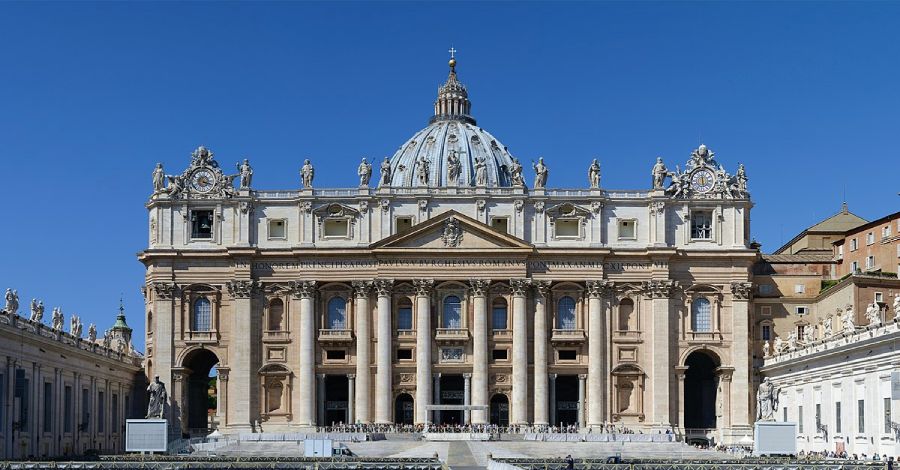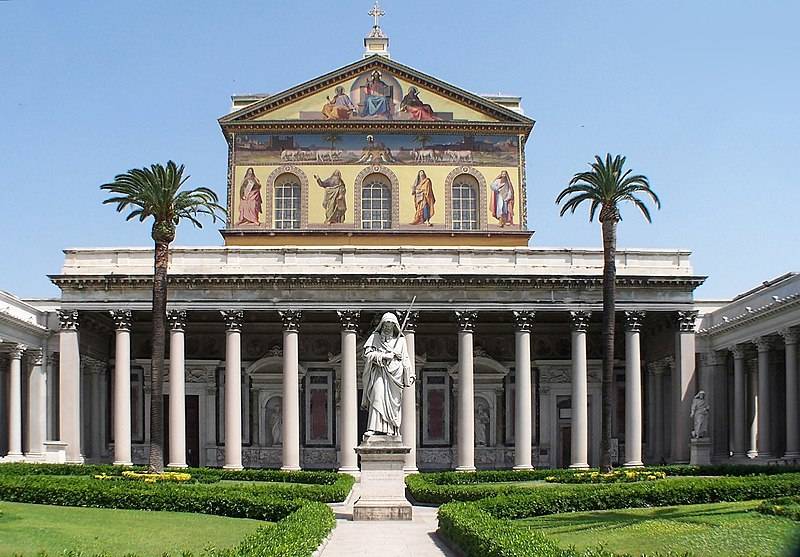18 November
Optional Memorial
Dedication of the Basilicas of Sts. Peter and Paul
The whole Church celebrates today the dedication of the two great Roman basilicas of St. Peter at the Vatican and of St. Paul-outside-the-Walls. The basilica of St. Peter stands on the site of the tomb of the Prince of the Apostles, where stood Nero’s circus. It was here that St. Peter was executed. Recent excavations have shown that the present basilica which, in the seventeenth century replaced the ancient Constantinian basilica, was built over the tomb of St. Peter, just as the previous basilica. It was consecrated by Urban VIII on November 18, 1626. St. Paul-outside-the-Walls, situated at the other end of the city on the Ostian Way, is built near the place St. Paul was martyred. It was almost completely destroyed by fire in 1823 and was rebuilt in sumptuous fashion by Gregory XVI and Pius IX and consecrated by the latter on December 10, 1854. The celebration of the anniversary of these two dedications has been kept, nevertheless, on November 18.
COLLECT PRAYER
Defend your Church, O Lord, by the protection of the holy Apostles, that, as she received from them the beginnings of her knowledge of things divine, so through them she may receive, even to the end of the world, an increase in heavenly grace. Through our Lord Jesus Christ, your Son. who lives and reigns with you in the unity of the Holy Spirit, God, for ever and ever.
Things to Do:
- Make a visit to a church today in honor of the two Princes of the Apostles.
- By cooperation with the plan of our Savior, Peter merited his glorious place in the center of Christendom — examine your conscience on how well you have corresponded with God’s grace.
- St. Paul chastised his body during life, make some sacrifice of food or drink.
- Teach your children what it means to be a temple of the Holy Spirit.
Dedication of the Churches of Peter and Paul
Today’s feast is a spiritual journey to two holy tombs, that of St. Peter and that of St. Paul in Rome. These two basilicas, marking the place of each apostle’s martyrdom, are the common heritage and glory of Christendom; it is, therefore, easily seen why we observe their dedication.
Abbot Herwegen makes the following observations on St. Peter’s in Rome. The Eternal City has two principal churches, St. John Lateran and St. Peter’s. Since ancient times the Lateran basilica, the mother of all churches on earth, has been the church proper to the bishop of Rome in his position as head of the local community. Here the Lenten season was opened and the Easter liturgy solemnized. The basilica of St. Peter, on the other hand, was the church of non-Romans, of pilgrims who journeyed to the city where the two great apostles were martyred. Here those celebrations were held which expressed the universal character of the Roman Church, e.g., Epiphany and the noon Mass on Christmas. The Introits, Lessons, and chants of both these feasts are best explained as proclaiming Christ’s universal dominion and His royal majesty.
The third lesson gives the history regarding the construction of the two basilicas. Among the holy places which the first Christians held in honor, those sites were especially dear where the bodies of holy martyrs lay. Great veneration was accorded that area of the Vatican Hill where the grave of St. Peter was located. From all lands Christians made pilgrimages to it as to the rock of faith and the foundation of the Church. In due time the legend arose that Emperor Constantine the Great, eight days after his baptism, took off his diadem, threw himself humbly upon the earth, and shed many tears. Then with pick and shovel he started digging and, in memory of the twelve apostles, carried away twelve baskets of ground; thereby he set the boundaries of the basilica to be built in honor of St. Peter. When finished, the edifice was solemnly consecrated by Pope Sylvester I.
Pope Sylvester had ordered the altar to be of stone; he anointed it with chrism and decreed that in the future only stone altars were to be used. A new church, the present St. Peter’s, was consecrated by Pope Urban VIII on November 18, 1626. The ancient basilica of St. Paul was destroyed by fire in 1823; a new structure was consecrated by Pius IX on December 10, 1854, the occasion of the proclamation of the dogma of the Immaculate Conception.
In the perspective of the liturgy, the two churches honored today are prime examples connoting the heavenly Jerusalem. The liturgy excels in the pedagogy of passing from the material to the supernatural — the precedent for which on the point in question was already set by the author of the Apocalypse.
Excerpted from The Church’s Year of Grace, Pius Parsch
Source: Catholic Culture

